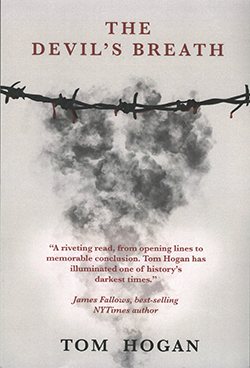The Devil’s Breath by Tom Hogan; (c) 2021; ISBN 9781736-943618; 261 pages, $17.95
By Donald H. Harrison

 SAN DIEGO — A Jewish detective imprisoned in Auschwitz is drafted by the camp commandant to determine who has stolen the ledger in which there is an accounting of the gold extracted from the bodies of murdered prisoners. Shimon Divko knows that he will be sent to the gas chamber whether he solves the mystery or doesn’t — the first alternative because he would then know too much; the second as punishment for failure.
SAN DIEGO — A Jewish detective imprisoned in Auschwitz is drafted by the camp commandant to determine who has stolen the ledger in which there is an accounting of the gold extracted from the bodies of murdered prisoners. Shimon Divko knows that he will be sent to the gas chamber whether he solves the mystery or doesn’t — the first alternative because he would then know too much; the second as punishment for failure.
So, in this novel, he refuses the assignment, wanting to at least keep his honor pure. However, the commandant was prepared for such an eventuality. If Shimon continues to refuse, then his wife Perla, an investigative journalist who also is a prisoner, would be tortured to death. A Hobbesian choice. Shimon opts to save his wife–if only for a little while–but insists that without her working by his side he won’t be able to solve the crime before Reichsfuhrer Heinrich Himmler makes his inspection tour of Auschwitz in just one week’s time. The commandant’s main worry is that the loss of the ledger will prompt Himmler to investigate who at Auschwitz has been keeping some of the gold for personal use.
In telling the fictional story of the subsequent investigation, author Hogan conducts readers on a grisly tour of Auschwitz camp operations, and also imagines candid conversations between the camp commandant (Rudolf Höss) and Shimon. Among the revelations, the commandant can watch without batting an eye innocents being conducted into the gas chambers, but is incredibly squeamish about watching gold being extracted from the teeth of the dead.
Preposterous as the plot may be, many readers will willingly suspend their disbelief in order to learn “whodunnit” and also whether Shimon and Perla somehow can stay alive. My personal reaction to the novel was a profound sense of unease. In concentrating so much on the mechanics of industrialized murder, Hogan desensitizes us to the suffering and heartbreak of the prisoners. Murdered human beings become mere numbers. Except for Shimon and Perla, the Jews still alive but suffering in the notorious concentration camp become background scenery to the detective story — another instance where our fellow Jews, the martyred Six Million, have been dehumanized. This, of course, was not Hogan’s intent, but that’s the feeling the novel left me with.
*
Donald H. Harrison is editor of San Diego Jewish World. He may be contacted via donald.harrison@sdjewishworld.com